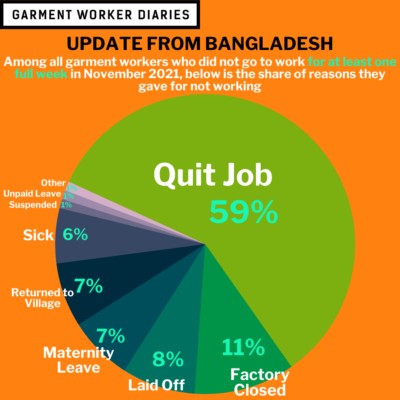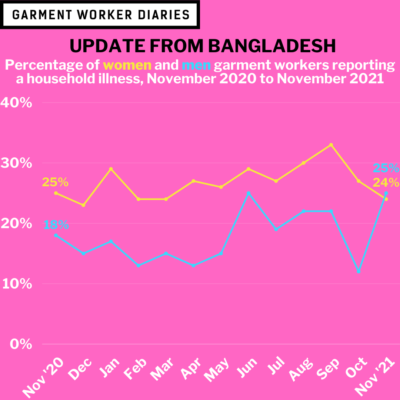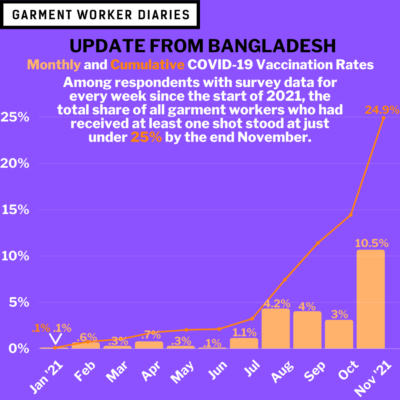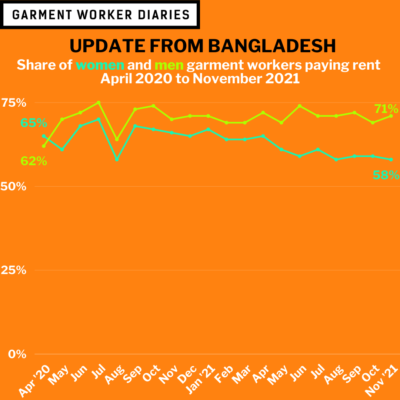Garment worker diaries blogs are back in 2022 with an update of our study through the end of November 2021. The data indicate that November and indeed all of this past autumn was a busy time for workers, as they spent almost as much time at their factories (and earned almost as much money) as in any other season over the past twenty months. While spending 280 hours a month inside of a garment factory can hardly be called humane, what their hard work confers is borne out by the food security data: more garment workers in November 2021 than in any month since the start of the COVID-19 pandemic told us that they felt they and their families were eating enough food from week to week.
There’s other good news, and interesting news, to read through below…
Note: Banner photo courtesy of a garment worker in Bangladesh; numbers in graphs may not sum to 100% due to rounding.
Employment
83% of all respondents reported going to work at some point in November 2021 (81% of women compared to 91% of men). Typical work hours were 280 for all respondents (279 for women, 282 for men), which is relatively high (the one month in the last twenty with higher median work hours was June 2021, at 282).
Regarding unemployment data, the traditional way we have been sharing this is to report non-working reasons for any worker who told us they did not go to work for any single day during the month. Among these workers, having quit one’s job (whether during the current month or in the past) was still the most likely reason for not having gone to work, representing 59% of the responses.
In addition to those partially unemployed (but also partially employed) workers, we analyzed data for the completely unemployed class of workers, meaning those who did not go to work for even a single hour during the month. Among these workers, the share of respondents saying they’d quit their job rose to 68%. This suggests that among what we might call the long-term unemployed, choosing not to go to work remains by far the most likely reason for staying at home.
And finally, within the context of COVID-19, there were no workers in November 2021 among either of these two groups who reported that the reason they stayed home was due to a lockdown or the need to quarantine.
Salary Payments
81% of all garment workers received a salary payment in November 2021 (79% of women and 87% of men; while it is usual for a lesser share of women to receive a salary than men, we might point out that 79% of women receiving a salary payment is the lowest share in the study thus far).
The typical salary payment amount for all garment workers in November 2021 was Tk. 11,500 (Tk. 11,200 for women and Tk. 12,650 for men). This is the 2nd highest median salary amount for all workers in the past twenty months, behind only July 2021’s median of Tk. 12,000 (which, not by coincidence, would have been the salary payment for June 2021, the month with the highest median hours).
58% of salary payments in November were made digitally, and 42% in cash, marking just over a year of almost unchanged shares for these two salary payment methods.
Digital Payments and Financial Transactions
Cash continued to predominate (by a wide margin) at home and in garment workers’ immediate surroundings when they made financial transactions in November 2021. And, as reported in nearly all other months in the study thus far, digital payments somewhat predominated when workers sent or received money transfers within their social networks outside the home. The overall frequency and typical amounts of all financial transactions (intra-household transfers, loans, savings, withdrawals, gifts, rents) also remained very much the same in November 2021 as in all preceding months.
One observation that might be worth noting is the widening gap between the share of women and men who pay rent each month. A higher share of women than men reported paying rent in April 2020, but since then, a higher share of men than women has reported paying rent each month, and the gap has been growing. In November 2021, 58% of women paid rent compared to 71% of men (June 2021’s gap was even wider, at 15%). From our experience, there is a correlation between whoever has greater control over household finances and the person who is making the household rent payment. So, this widening rent payment gap could be indicating something about how the gender dynamics of household finances have been shifting during the pandemic.
Food Security and Household Illness
Looking at the past twenty months, food security rates in November 2021 were at their highest reported rates thus far. Specifically, we were told that 89% of workers, 89% of heads of households, and 92%, of workers’ children had eaten enough during each week in the month.
24% of all workers reported a household illness in November 2021, identical to the report in October. But while the share of women reporting a household illness remained rather comparable to the October share (24% and 27%, respectively), the share of men reporting a household illness in November compared to October more than doubled (25% in November compared to 12% in October). This is the highest recorded jump in household illness rates reported by men thus far in the study, and it is also the first month since April 2020 in which a higher share of men reported a household illness than women.
COVID-19 Vaccination Rates
We looked at all respondents who have submitted survey data for each week of 2021 starting in January. Among these 1,088 respondents who had not missed a single week of data collection, about 25% had received a COVID-19 vaccination shot by the end of November 2021. From August to October, the monthly share of this sub-set of respondents who were getting a vaccination shot hovered around 3%-4%. However, the share of respondents in November who reported getting a shot jumped considerably, to about 10.5%. Continuing at this rate, all of the respondents in this sub-set of our study will have received a COVID-19 vaccination shot sometime around July 2022, a much earlier timeline than depicted in projections from prior blogs when the monthly vaccination rate was lower.
However, we must note that isolating this sub-set of “steady” respondents to obtain our study’s COVID-19 vaccination rate has its caveats. Most importantly, it biases in favor of those respondents who are likely to have been employed for the entire period from January to November (respondents who hold steady jobs over long periods of time tend to not move locations and thus not drop out of our study or miss a week of data collection). And, for those respondents with jobs, the likelihood is greater that they will have access to vaccination services through their factories. It is worth mentioning at this point that among all respondents in our study, and not just those with 100% complete data sets, that the overall share of having received a COVID-19 vaccination shot is about 22%, somewhat lower than the 25% for the sub-set quoted above.
The data are drawn from interviews with about 1,300 workers interviewed weekly from April 2020 to November 2021. The number of worker responses in a particular month varies depending on interview participation rates throughout the month but were never below 1,206 during this period. These workers are employed in factories spread across the five main industrial areas of Bangladesh (Chittagong, Dhaka City, Gazipur, Narayanganj, and Savar). Just over three-quarters of the working respondents are women, roughly representative of workers in the sector as a whole.








